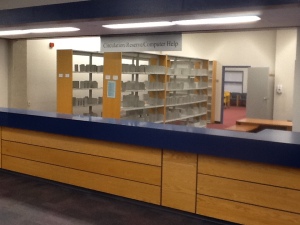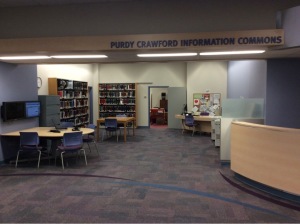Home » Posts tagged 'Libraries'
Tag Archives: Libraries
Doing It Right! Creating New Service Spaces
Libraries are changing (understatement)! We often talk a lot about changes to library technical services like book buying and cataloging but public services have also dramatically changed. Our clients are more self reliant, more collaborative, and are now digital natives. The Sir James Dunn Law Library Public Services areas had been designed for a different time and had remained largely unchanged since 1989. We also wrestled with decreases in our budget and staff numbers so business as usual was no longer possible. After several years of planning and fundraising we started a services area renovation. I served as the onsite Project Coordinator for this renovation. In librarian fashion we began by searching the library design literature, consulting experts, and visiting others libraries. So many ideas to sort through! Another part of my job was to work with stakeholders such as staff, faculty, and students to understand their needs for our new space. Librarians needed Reference and Teaching spaces that more reflected, for example, the come-alongside style of consultation rather that the old fashioned reception desk. We needed to bring together related services, and re-orienting our offices we could create a Services space. We needed better lines of sight in order to improve security. Students and faculty wanted different work areas and more one stop services. Staff filled out surveys on their ideas and suggestions, I hosted a focus group of students, and presented designs in a faculty meeting. You can download the design powerpoint presentation here (turn on your speakers and I’ll narrate the design presentation.)
The services space started to come together: the new desk moved to a more central location by the main entrance. The Reference and Circulation Desks were combined at the new location.
Past the One Desk you will find our printing stations, self checkout, the Circulation Supervisor’s office, the Reference office and IT Support. Our Reserve Collection came out from behind the desk and became a self serve collection. It probably doubled the use of this collection because now students could browse. Never underestimate serendipity in research. Perhaps the most important part of the new design is the focus on client needs. We wanted to create work and learning spaces that fit our clients lives. Our clients loved the changes. There were also policy and services changes to match the new space, and staff had to do their jobs differently. We never closed during the reno and our incredible library staff never missed a beat. It wasn’t a perfect reno and it consumed countless hours of my life as we addressed problems and resolved deficiencies. I certainly appreciated the support of the Dean, Law School Manager, and, I can’t say enough about Dal’s Designer and Project Managers. Renovations in an large organization like Dalhousie are cumbersome at best, and at times it can be tempting to give up. But we saw it through, and we served our clients well!
The Future Now: Canada’s Libraries, Archives, and Public Memory
In 2013 the Royal Society of Canada embarked on an initiative to investigate the work of Canada’s memory organizations. The mandate of the appointed expert panel was:
- To investigate what services Canadians, including Aboriginal Canadians and new Canadians, are currently receiving from libraries and archives.
- To explore what Canadian society expects of libraries and archives in the 21st century.
- To identify the necessary changes in resources, structures, and competencies to ensure libraries and archives serve the Canadian public good in the 21st century.
- To listen to and consult the multiple voices that contribute to community building and memory building.
- To demonstrate how deeply the knowledge universe has been and will continue to be revolutionized by digital technology.
- To conceptualize the integration of the physical and the digital in library and archive spaces
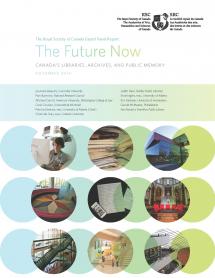 The panel traveled across Canada holding hearings, and I, among many stakeholders, spoke during one of those hearings about the future of libraries. I spoke from my perspective as a longtime professional librarian and more recently a PhD student. When the Final Report (pdf) came out I was pleasantly surprised to find myself quoted (p. 173), not for anything I said in the hearings but from an online discussion on the APLA listserv about libraries and technology:
The panel traveled across Canada holding hearings, and I, among many stakeholders, spoke during one of those hearings about the future of libraries. I spoke from my perspective as a longtime professional librarian and more recently a PhD student. When the Final Report (pdf) came out I was pleasantly surprised to find myself quoted (p. 173), not for anything I said in the hearings but from an online discussion on the APLA listserv about libraries and technology:
When we can’t be there: The Self-Guided Tour
Each year we offer walking tours of our library. Some years they are well attended but many years they aren’t. Hard to blame 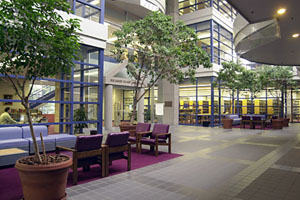 students; the beginning of the year is busy and they are feeling a little overwhelmed! But we can’t drop everything and provide students tours when they realize they need it. Well, sometimes we do, but often that realization occurs at time when we aren’t around.
students; the beginning of the year is busy and they are feeling a little overwhelmed! But we can’t drop everything and provide students tours when they realize they need it. Well, sometimes we do, but often that realization occurs at time when we aren’t around.
Museums, like the National Art Gallery, handle that with audio tours. We discovered that the Morisset Library at the University of Ottawa had developed an audio tour. They provided a map of key sites, a print version of the tour, and used QR Codes posted to link to the audio files. Well why couldn’t we do that? In 2013 we started our audio tour project.
 Step One: We began by mapping out our library and determining key tour stops.
Step One: We began by mapping out our library and determining key tour stops.
Step Two: We created a script for each tour stop.
Step Three: We timed our scripts…too long…so we edited them down. We decided to keep the tour under twenty minutes so less walking from site to site we had to keep the audio under 20 minutes.
Step Four: We recorded our audio tour using a Blue Snowflake microphone, and processed it using Audacity software on a Macbook.
Now how will we deliver the tour? We chose to upload them to a public dropbox folder. They were available from select online guides. But what if a visitor didn’t know about the guides? At each site we posted a sign and a QR Code linking to that section of the tour.
“The six audio files (mp3) can be downloaded to provide a guided walking tour of the Sir James Dunn Law Library. You can download the tour transcript here (pdf).”
- Station 1: Atrium (mp3) 1:20 min.
- Station 2: Information Services Centre (mp3) 2:15 min.
- Station 3: Canadian Primary Sources (mp3) 2:21 min.
- Station 4: General Collection (mp3) 2:22 min.
- Station 5: Journals (mp3) 1:48 min.
- Station 6: Foreign Sources (mp3) 2:31 min.
The library is undergoing significant renovations and collections have moved. We will need to redo the audio tours but they did provide one more way to help our clients navigate when we couldn’t be there to help them. Special thanks to Nikki for all her work on this project!
21st Century Research Support Services
In libraries we often speak about being client-focused. Last year I visited the Apple store to get a laptop repaired. I made my appointment on online at a convenient time for me. I arrived at the “genius bar” at the scheduled time and the staff swiftly and expertly addressed my problem. The store was packed with scheduled and dropin clients. I wondered why libraries can’t offer that kind of service. In most academic libraries one emails a librarian and there is a back and forth trying to schedule a time. Most librarians are often busy with other duties and committees. Increasingly the libraries’ genius bar” is closed.
time and the staff swiftly and expertly addressed my problem. The store was packed with scheduled and dropin clients. I wondered why libraries can’t offer that kind of service. In most academic libraries one emails a librarian and there is a back and forth trying to schedule a time. Most librarians are often busy with other duties and committees. Increasingly the libraries’ genius bar” is closed.
 I wondered why we couldn’t offer services like that?
I wondered why we couldn’t offer services like that?
I started first with the ability to schedule online appointments. I can’t be there all the time but I can post my schedule online and they can choose a time that works for them. So first of all, Apple doesn’t sell its scheduling software. I did find many different types of client scheduling software. Most of these are cloud based so I need to be careful of where client data resides. I chose a service that is based in Canada with strong client privacy policies. I wanted to start it small and scale up as needed. I wanted the ability to be notified by email when a client scheduled an appointment.
I found the perfect software in BookedIN, an app used by professionals like accountants, therapists, and hairdressers to schedule appointments. The software displays my available schedule and allows clients to book appointments for a variety of activities such as a Research Consultation or Database training. They can provide additional information so I can prepare accordingly for the session. When an appointment is made the client and I receive a notification and the client will receive a reminded before the appointment. 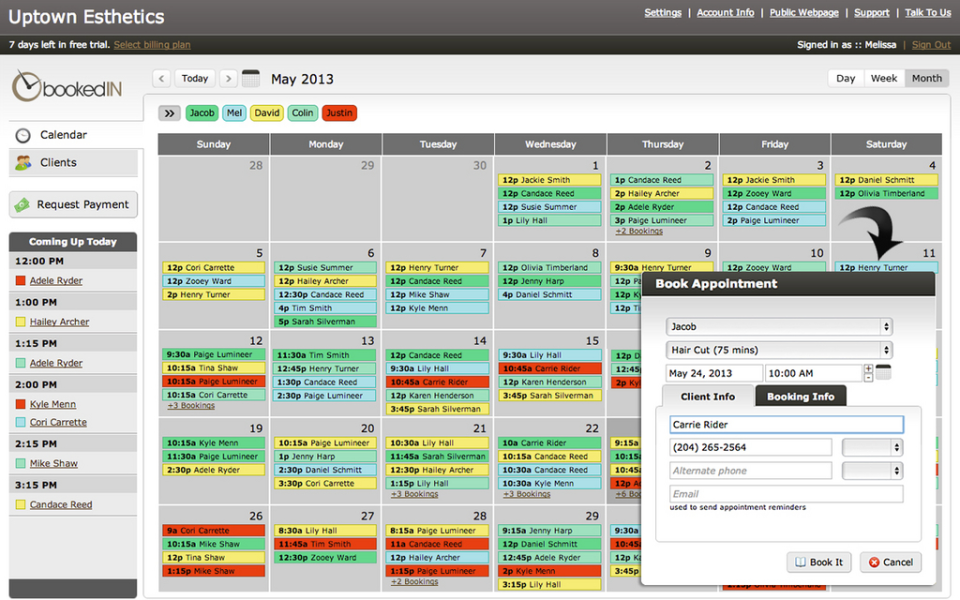
My clients have more control; they don’t need to keep dropping by to see if I’m available. I also appreciate not playing email/phone tag anymore when scheduling appointments. Ok, still not the Genius Bar but one step closer.
Photo Credits: Alper Cugun, “Genius Bar”, May 16, 2008, https://flic.kr/p/4PmipR, Windward CC Library, “Reference Desk”, Feb. 11, 2008, https://flic.kr/p/4rCHR6
David’s Manifesto
Need I say that libraries are changing? Special libraries, public libraries, and academic libraries are all trying to redefine themselves. We need to be reflective and responsive; that is a good thing. I am concerned that academic libraries are still having a hard time letting go of the need to be a “big box of books.” We have shifted our focus from paper to digital documents. We collect e-books and plead with faculty to give us their pre-prints for our repositories. We want to archive data (though it remains unclear if we really understand data). Don’t get me wrong, there is a role to play here. However, I see these initiatives as transitory. The Googles of this world will eventually decide that they are better at archiving and delivering our digital content, for much cheaper, and University Admins will outsource to them. The age of the information intermediaries is drawing to a close.
As the information world becomes more complex, and the amount of information increases exponentially, even digital natives are finding it hard to navigate that ocean of information. What they need are experts in the nature, forms, and locations of information. They need skilled guides, navigators, and instructors. We are very good at these things. But they won’t find us if we stay hidden within the walls of our book fortresses. Below is my call and manifesto for library change.

